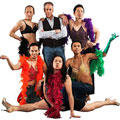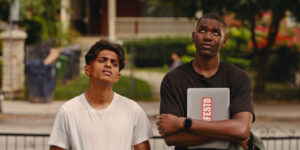Philip Himberg with the cast of Paper Dolls.
Philip Himberg, Artistic Director, Theatre Program
Philip Himberg is the Artistic Director of the Sundance Institute Theatre Program where he works to support the projects of theatre artists around the world. He is currently in London putting the final touches on his adapted play ‘Paper Dolls,’ which opens at the Tricycle Theatre on March 6.
For nearly 17 years, I’ve had the amazing good fortune to work as Artistic Director of the Sundance Institute Theatre Program. My role (which I love) is largely about supporting the work of other artists and it focuses on what we call dramaturgy: creating meaningful lab environments that inspire new work, and an informed ‘spirit of inquiry’ around other people’s plays. When we do our work well, a Sundance “fellow” – an author or composer – finds the ability to take risks in their writing, to plumb more deeply their creative impulses, and hopefully to best articulate and land the vision that inspired them.
Today, I’m 4,000 miles from my Sundance home – figuratively and literally – and in a spectacular twist of life, on the other side of the dramaturgical table. At this moment, I am the playwright, in London, where the world premiere of my play Paper Dolls takes place on March 6 at the Tricycle Theatre.
I’ve written before, including one play – a one-woman show for actor/singer Maureen McGovern, called Carry It On. Maureen and I collaborated as authors on that one, and because it was a solo piece with a lot of music, it provided its own special challenges. In the end, we were given several opportunities to workshop the play, and eventually landed four terrific productions at some of the top U.S. regional theatres: in Boston, Washington D.C., New Jersey and Rochester.
But Paper Dolls is a bit different and way more ambitious. First off, it’s big: 13 actors, 20 locations – based, in part on a documentary film. When I saw the movie in its U.S. premiere at the Los Angeles Film Festival, I literally leapt from my seat after the screening and accosted the filmmaker, Tomer Heymann – eager to convince him that his amazing piece might translate onto the stage. That was 2006. Seven years later, I’ve traveled to Israel, where the film took place, and where Tomer graciously showed me around. I’ve met the actual “Paper Dolls” (Filipino care-givers, several of whom now live in London) and I’ve had the luxury of two workshops in New York with great actors, directors, and dramaturges.
Before that, the actual writing – putting pen to paper – began at the Sundance Playwrights Retreat at the Ucross Foundation in remotest Wyoming. During the evening hours, I read and met with our Sundance playwright and composer ‘fellows,’ often answering their own questions about their scripts. But during the day, when they were ensconced in their studios, I followed suit. I sat day after day before my laptop, staring at the elk outside my windows and dreaming of how to adapt a real life documentary into something theatrically moving, dynamic and truly stage worthy. Eventually, it meant taking the cold plunge – inventing new characters and dialogue, changing and altering situations and relationships. And I wrote, steadily for 18 days. When I departed Ucross, I had a first draft tucked under my arm.
Twenty-five plus drafts later, and today we are currently six days from our first audience. We’ve been in rehearsal here at the Tricycle – in the wonderfully diverse neighborhood of Kilburn – for a month. I’ve never worked harder in my life. Listening carefully as these supremely talented actors found the truth of their characters, learning to cut and edit and re-arrange and ‘kill my babies’ as they say. Working with Indhu Rubasingham, director extraordinaire, has been a true gift. She illuminates the storytelling of my own play, always respectful but also tough, pushing me to think more deeply about what needs to be on the page, and on the stage, and on the other hand, what can be gracefully tossed into the waste bin.
Today we begin tech and costumes and it’s suddenly hard for me to find my place in the room. Most of my work is actually done. Yes – there will be trims and tweaks as the physical life of the play finds its rhythms, with a set, lights, costumes, but mostly, I wait. I wait to see if the my own impulses and my own truth ‘land’ in front of an audience in eight days, and based on their response, there will likely be more sculpting of the writing too. After all, it’s a brand new play, and the audience will teach us as much as anything that has come before.
My mind is a bit of a jumble these days, yet I have no doubt about one thing: that I will return to my full time role at Sundance – in a few weeks – an even more compassionate and perceptive ‘dramaturg’. Now I know, quite viscerally, that when you generously and with the best of intentions turn to a writer and suggest a ‘change,’ it means that that artist will go back to a lonely room, face an empty page or blank screen, and need to dream deep and trust a real solution.
I know, firsthand, how that white page can be quite intimidating. Or, on the other hand, as Stephen Sondheim puts it: Endless possibility.
Philip Himberg
London, February 22, 2013







